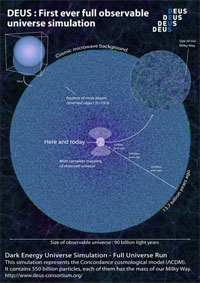
Work lasting many years has culminated in the first simulation of the structuring of the whole observable Universe, from the Big Bang to now, realised by six scientists (3) from the Cosmology team of the LUTH. Over and beyond the standard cosmological model with the cosmological constant, which they have just finished, their work has highlighted two other cosmological models which include dark energy, (4), a mysterious component which was introduced to explain the accelerated expansion of the universe (5). What is the “footprint” left by dark energy on the structure of the Universe ? And inversely, how can one deduce from the structuring of the universe the nature of this energy ? These are the two fundamental questions which the project Deus : full universeruntentera will try to answer.
The standard cosmological model simulation which has just been finished, has already enabled the number of galaxy clusters more massive than 100 million solar masses, to be determined – today, there are over 144 million.. Another piece of information : the first cluster of this type was born when the Universe was only 2 billion years old and the most massive cluster in the observable Universe today weighs in at 15 million billion solar masses. Furthermore, the data produced during the calculations enable the fluctuations in the distribution of dark matter to be determined. These latter are are a consequence of fluctuations in the cosmological background radiation produced by the Big Bang, and observed by the WMAP and Planck satellites.

These observations are reproduced in a simulation which covers the entire history of the Universe, with an unparalleled precision and over a spatial range of several thousandths of the size of the Universe, a range which has never been observed. The effect of the oscillations of the primordial gas (“Baryon Acoustic Oscillations”) is revealed with precision. These calculations are already emerging as a rich mine of new results for the entire cosmological community.
This remarkable project could be realised thanks to the powerful computational resources placed at the disposal of the scientists by the GENCI (6) (the Grand Equipement National de Calcul Intensif) ; these involved the supercomputer CURIE, containing over 92 000 computational units and able to do 2 million de billion operations per second (2 PFlop/s). The CURIE machine is housed at and used by the CEA at the Très Grand Centre de Calcul, at Bruyères-le-Châtel (Essonne). Designed byr Bull, it is among the five most powerful computers in the world.
Deus : full universerun constitutes a new step far beyond the most efficient calculations done so far by any international team using even the largest computers in the world. The complete project will require more than 30 million hours of computation (almost 3500 years) spread over practically all the computational units of CURIE. Over 150 péta-octets of data (i.e. the equivalent of 30 million DVDs) will be produced during these calculations. An advance innovative selection procedure will reduce this to 1 Po of useful data.
It is already possible, for the standard model with a cosmological constant, to study the distribution of dark matter and energy, as well as that of galaxies, over distance scales equivalent to 90 billion light years (7), and to study their evolution over the entire history of the universe.

The results of these trips through the observable universe, from here and now up to the limit of the Big Bang, for the three cosmological models, will be available towards the end of next May. They will lead to a better understanding of the role of dark energy in the structuration of the universe ; moreover, they will constitute an invaluable aid for the creation and interpretation of present and future cosmological “catalogues” generated by the large observational projects, and in particular those (such as EUCLID (8), which has just been selected by the European Space Agency ESA) envisaged by the major space agencies.
- The LUTH is a laboratory of the Observatoire de Paris/CNRS/Université Paris Diderot and a scientific department of the Observatoire de Paris.
- DEUS : DarkEnergyUniverse Simulation, www.deus-consortium.org
- Jean-Michel Alimi, Pier-Stefano Corasaniti, Yann Rasera, Irène Balmes, Vincent Bouillot, Vincent Reverdy.
- The first model is the concordance model, which includes a cosmological constant. In the second model, a dynamical dark energy component fills the entire universe. Finally, in the third model, a so-called “phantom” acceleration field “mimes” a modification of the law of gravitation at large scales..
- The 2011 Nobel Prize in physics was awarded for the discovery of the accelerated expansion of the universe, whose cause is imputed to dark energy.
- www.genci.fr
- In a universe aged about 13,7 billion years, the light which is reaching us will have covered a distance larger than 13,7 billion light years, because the universe has expanded during this time. This distance is in fact a function of the cosmological model. Since space is expanding, the distance covered by the light increases constantly, so that the light covers in fact roughly 45 billion light years.
- EUCLID is one of the missions of ESA’s Cosmic Vision program for the period 2015-2025. EUCLID will study the origin of the accelerated expansion of the universe.http://www.esa.int/esaSC/SEMOZ59U7TG_index_0.html
Picture
For more photos
